I’m relaxing and soaking up the atmosphere when they show up.
“You have 20 minutes here to take photos,” their leader yells into a loudspeaker, and then they swarm. I’ve already spent a few hours at the site and I still feel there’s more to explore — but it’s time to leave.
I was 16 years old the last time I joined a tour group. It was some “Wonders of China” jaunt that my family decided to go on; the schedule was so hectic that even the tour leader began calling us a “band of herded ducks” (趕鴨子團). I’ve mostly traveled on my own after that, usually with no set itinerary.
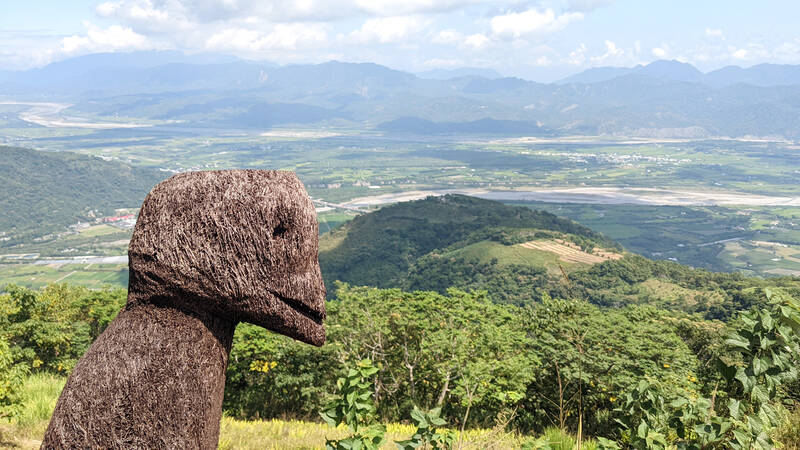
Photo: Han Cheung, Taipei Times
Two few weeks ago, I found myself indulging in a seven-course, locally sourced “hunter’s table” meal on a mountainside landing with sweeping views of the valley below. Our indigenous Bunun hosts from Uninang Multicultural Workshop (烏尼囊多元文化工作坊) are singing traditional songs and keeping the millet wine flowing, while talking about the food and cultural activities. It’s a bit too packaged, but I probably wouldn’t have experienced any of it if I’d stumbled into these parts on my own. Plus, they have a 15-person minimum for the meal.
The experience was part of a three-day East Rift Valley familiarization tour (for industry and media) by MyTaiwanTour that focused on indigenous food and culture — emphasis on the food. The schedule was leisurely with just a few destinations per day, and we had ample time to chat with locals and understand how they’re attempting to bring a more sustainable and in-depth kind of tourism to their homes.
Personally, I’d hoped for a lot more physical activity — especially given how much we ate — but that’s the thing with groups: you have to be accommodating. Still, it was much more enjoyable than I had expected.
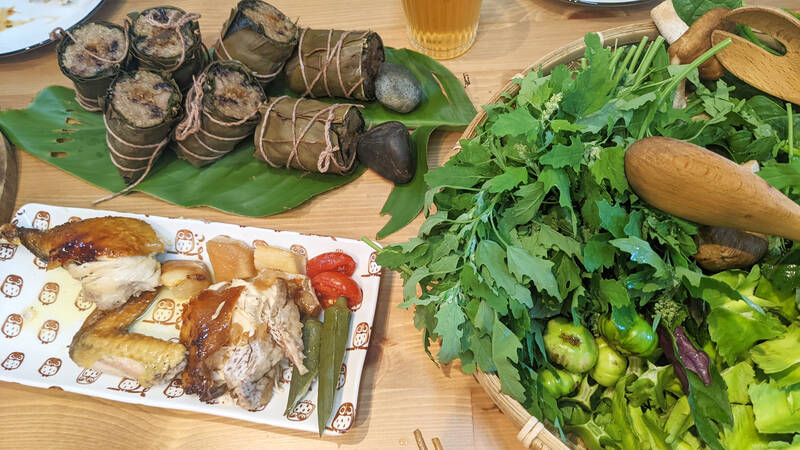
Photo: Han Cheung, Taipei Times
HUNTER’S TABLE
Uninang — meaning “thank you” in Bunun — was our first stop. We meet our guides on the side of a road, where they perform a blessing ceremony before we head to the hunting trail. While they keep the mood light by continuously cracking the Taiwanese equivalent of dad jokes, we learn much about how they mark the trails, track and trap animals. Their deep understanding of the natural surroundings is apparent.
Afterward, we hike up a short trail to a clearing, where we engage in archery and spear throwing contests. Spear throwing is harder than it looks, and barely anyone hits the target. After the “award ceremony,” the guides demonstrate how hunters would shout when they near the village to let their loved ones know they’re back.
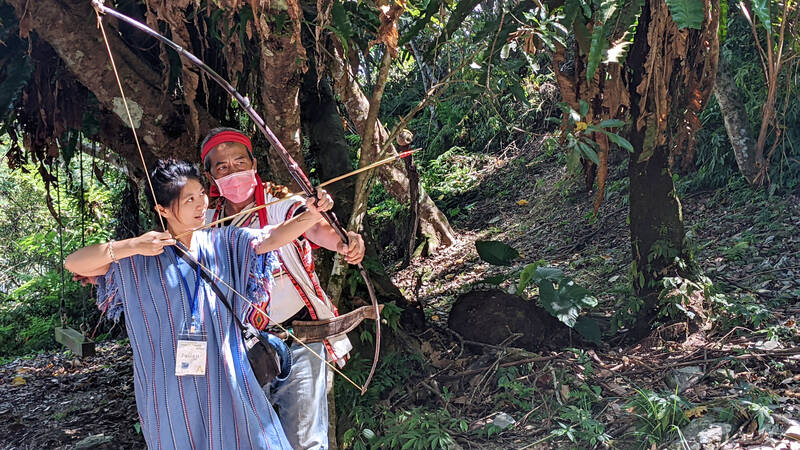
Photo: Han Cheung, Taipei Times
We hear people responding from the top of the ridge, and as we climb to the top, a stunning view of the plains below is suddenly revealed. The hosts greet us warmly, and we head to the dining area, which consists of individual block tables surrounding two gravel fire pits. It’s traditional and chic at the same time, and so is the cuisine; the menu is translated into English and printed on a thin wooden square.
We grill our own meat for the first dish, but the rest is served by the hosts. It’s simple, hearty and attractively-presented, and we hear more about the traditions involved. After the meal there’s a flurry of Bunun cultural activities: festival dancing, eight-part pasibutbut harmonizing and millet pounding. It’s unclear how authentic this part is removed from its original context, especially when everyone is asked to wear indigenous costumes, most of which aren’t even Bunun. It’s an odd choice that’s never explained, and perhaps many tourists can’t tell, or don’t care.
I could have done without the last part; I was aching to do more hiking but we’re rounded up into the van for dinner. Didn’t we just eat?
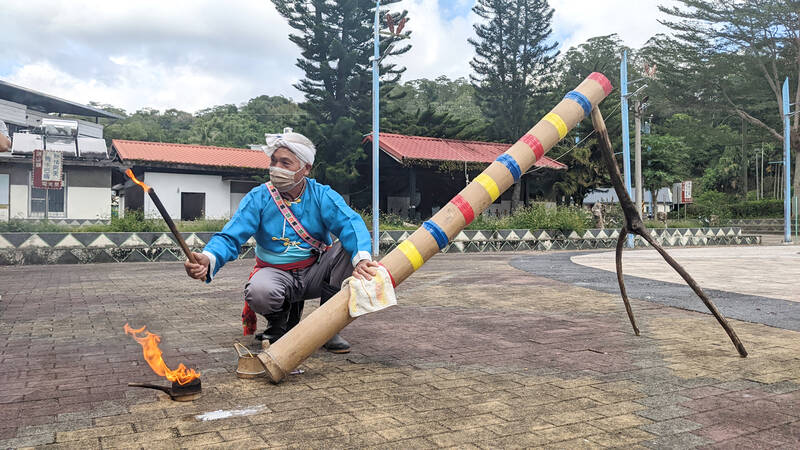
Photo: Han Cheung, Taipei Times
SLOW FOOD
Well, when I laid eyes on the mountain pepper pizza at Chubby Rabbit (恰比兔子), a cozy European-style home kitchen run by a German chef, I didn’t mind eating again. Almost all the places that we eat at are certified by Taitung’s Slow Food Review, which emphasizes local and seasonal ingredients, environmental friendliness and fair and equal interaction between the producers, restaurant and customers.
The hosts all seem friendly and eager to talk, although it’s rather chaotic with them trying to serve such a large group. We stayed at a peculiar, American baseball-themed “resort” that belongs in the 1990s. The tour leader says they cut down on lodging costs to focus on the food, and I didn’t mind that at all. It was clean and comfortable.

Photo: Han Cheung, Taipei Times
The next day we head to Kaadaadaan, a quiet Amis village surrounded by verdant rice paddies. Our host is Tiyansu Pawtawan, an organic rice farmer in his early 30s who grows and roasts his own coffee beans at his shop, Richuhezuo (日出禾作). Huang is among a growing number of young people who choose to return to their home village and try to revitalize their hometowns.
Besides the coffee, his shop’s signature offering is a rice square topped with silaw — Amis pickled raw pork that his grandmother taught him how to make. It’s slightly seared to cater to visitors.
After roasting coffee beans we eat once again, at Baoma Canteen (寶媽食堂), where we’re presented with a sumptuous spread complete with a huge array of wild greens.
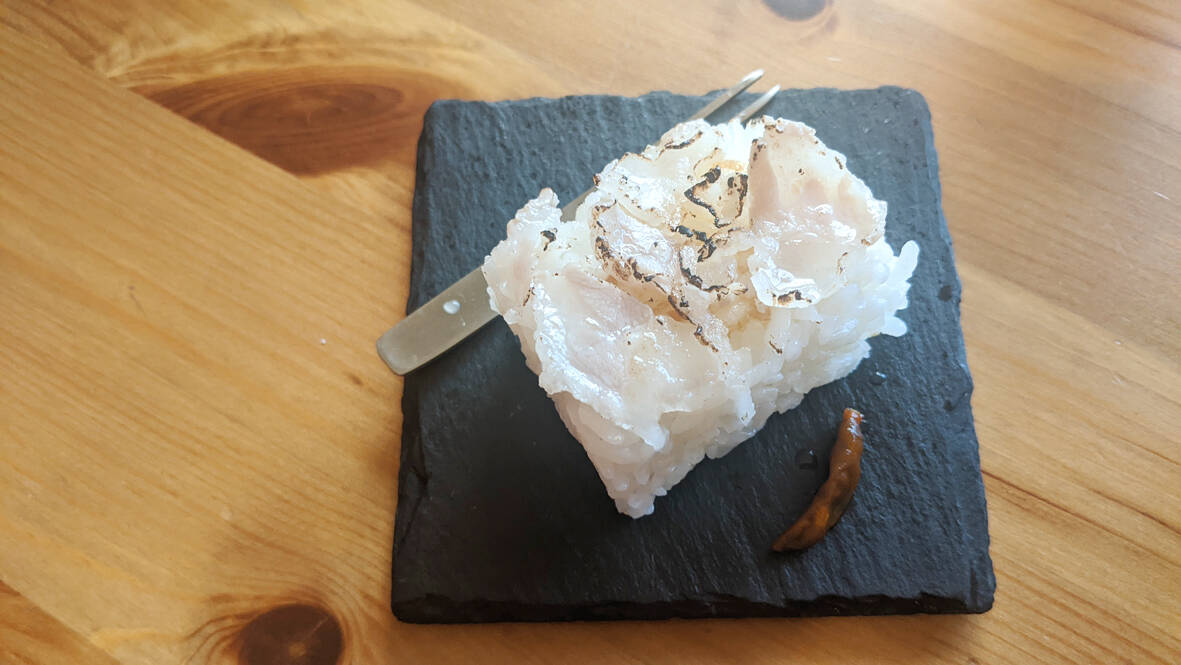
Photo: Han Cheung, Taipei Times
Again, the chef explains where the ingredients come from and how they tie into local culture. I’m so full that I go for a walk, but I’m summoned back quickly to join Tiyansu’s tour of the village, where we learn about its history and how they overcame many hardships to settle in this land. We take turns setting off a deafening bamboo cannon, which locals once used to scare off invading Qing Dynasty soldiers.
GEOTHERMAL SPRINGS
I was excited to bike around the paddy fields in Guanshan (關山), but it turned out to be electric, four-person tandem bikes that required no pedaling. The scenery was pretty, but I told them that Western visitors would definitely want to ride on their own. The local guide also talked the entire time through a wireless earpiece, and I barely caught any of it while trying to steer the vehicle and admire the views.
Dinner was another huge, festive meal at Kanasuoi (卡納歲) featuring Taiwan oil millet (油芒), a long-lost crop that the restaurant owners are trying to restore. Extremely hardy and drought resistant, it’s been touted as a super food that’s vital to food security as climate change worsens. As usual, the courses are immaculately presented and flavorful.
The final stop also ties into the environment. Vakangan Green Energy Hot Spring Park (紅葉谷綠能溫泉園區) is a geothermal plant combined with a state-of-the-art hot springs recreational area. We first tour the plant and green energy exhibition before dipping into the excellent facilities. We’re served another impressive meal here, but I can’t talk about food anymore at this point.
While it’s still not the way I prefer to travel, the trip overturned my impressions of group tours. I learned a great deal about the land, culture and sustainability, and ate at places I would not have bothered looking up. This is definitely the right step for domestic tourism, as it presents these in-depth local connections in a comfortable, almost luxurious (for me at least) manner, and still provides picture-perfect spots for that Instagram selfie.
There was discussion during the tour on how this trip would work with foreigners, as the hosts mostly lack English skills. While the tour leaders can help translate, it’s hard to have a deeper interaction. There is an ongoing effort to train indigenous English tour guides, and promoting this area is important as Taiwan opens its borders again.

This month the government ordered a one-year block of Xiaohongshu (小紅書) or Rednote, a Chinese social media platform with more than 3 million users in Taiwan. The government pointed to widespread fraud activity on the platform, along with cybersecurity failures. Officials said that they had reached out to the company and asked it to change. However, they received no response. The pro-China parties, the Chinese Nationalist Party (KMT) and Taiwan People’s Party (TPP), immediately swung into action, denouncing the ban as an attack on free speech. This “free speech” claim was then echoed by the People’s Republic of China (PRC),

Exceptions to the rule are sometimes revealing. For a brief few years, there was an emerging ideological split between the Democratic Progressive Party (DPP) and Chinese Nationalist Party (KMT) that appeared to be pushing the DPP in a direction that would be considered more liberal, and the KMT more conservative. In the previous column, “The KMT-DPP’s bureaucrat-led developmental state” (Dec. 11, page 12), we examined how Taiwan’s democratic system developed, and how both the two main parties largely accepted a similar consensus on how Taiwan should be run domestically and did not split along the left-right lines more familiar in

As I finally slid into the warm embrace of the hot, clifftop pool, it was a serene moment of reflection. The sound of the river reflected off the cave walls, the white of our camping lights reflected off the dark, shimmering surface of the water, and I reflected on how fortunate I was to be here. After all, the beautiful walk through narrow canyons that had brought us here had been inaccessible for five years — and will be again soon. The day had started at the Huisun Forest Area (惠蓀林場), at the end of Nantou County Route 80, north and east

Specialty sandwiches loaded with the contents of an entire charcuterie board, overflowing with sauces, creams and all manner of creative add-ons, is perhaps one of the biggest global food trends of this year. From London to New York, lines form down the block for mortadella, burrata, pistachio and more stuffed between slices of fresh sourdough, rye or focaccia. To try the trend in Taipei, Munchies Mafia is for sure the spot — could this be the best sandwich in town? Carlos from Spain and Sergio from Mexico opened this spot just seven months ago. The two met working in the